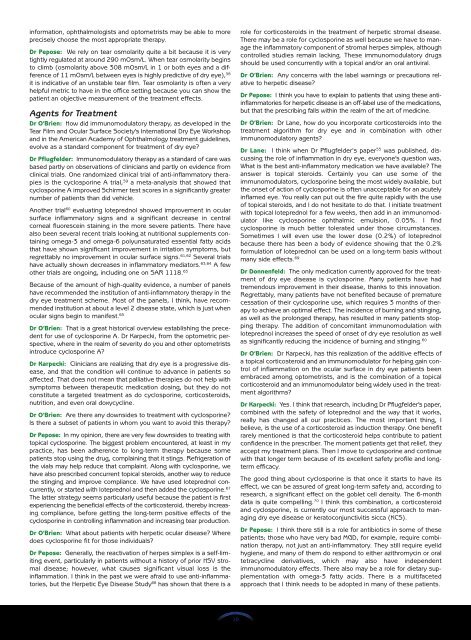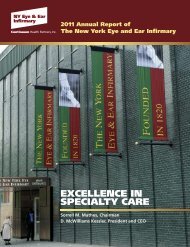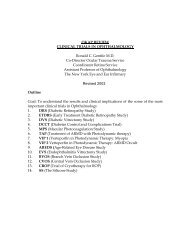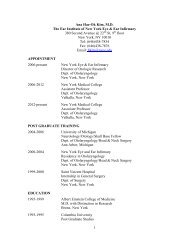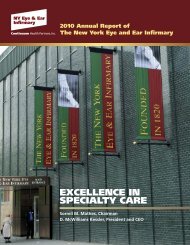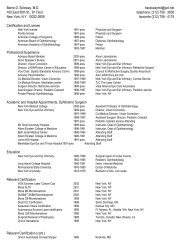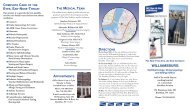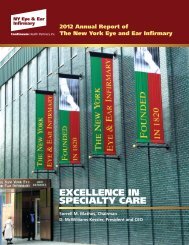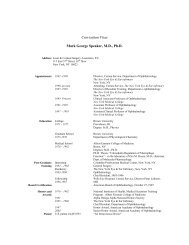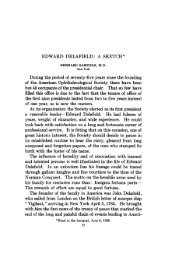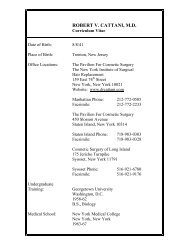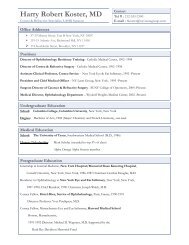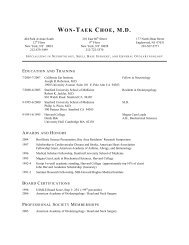Prevention and Management of Ocular Inflammation - New York Eye ...
Prevention and Management of Ocular Inflammation - New York Eye ...
Prevention and Management of Ocular Inflammation - New York Eye ...
You also want an ePaper? Increase the reach of your titles
YUMPU automatically turns print PDFs into web optimized ePapers that Google loves.
information, ophthalmologists <strong>and</strong> optometrists may be able to more<br />
precisely choose the most appropriate therapy.<br />
Dr Pepose: We rely on tear osmolarity quite a bit because it is very<br />
tightly regulated at around 290 mOsm/L. When tear osmolarity begins<br />
to climb (osmolarity above 308 mOsm/L in 1 or both eyes <strong>and</strong> a difference<br />
<strong>of</strong> 11 mOsm/L between eyes is highly predictive <strong>of</strong> dry eye), 58<br />
it is indicative <strong>of</strong> an unstable tear film. Tear osmolarity is <strong>of</strong>ten a very<br />
helpful metric to have in the <strong>of</strong>fice setting because you can show the<br />
patient an objective measurement <strong>of</strong> the treatment effects.<br />
Agents for Treatment<br />
Dr O’Brien: How did immunomodulatory therapy, as developed in the<br />
Tear Film <strong>and</strong> <strong>Ocular</strong> Surface Society’s International Dry <strong>Eye</strong> Workshop<br />
<strong>and</strong> in the American Academy <strong>of</strong> Ophthalmology treatment guidelines,<br />
evolve as a st<strong>and</strong>ard component for treatment <strong>of</strong> dry eye?<br />
Dr Pflugfelder: Immunomodulatory therapy as a st<strong>and</strong>ard <strong>of</strong> care was<br />
based partly on observations <strong>of</strong> clinicians <strong>and</strong> partly on evidence from<br />
clinical trials. One r<strong>and</strong>omized clinical trial <strong>of</strong> anti-inflammatory therapies<br />
is the cyclosporine A trial, 59 a meta-analysis that showed that<br />
cyclosporine A improved Schirmer test scores in a significantly greater<br />
number <strong>of</strong> patients than did vehicle.<br />
Another trial 60 evaluating loteprednol showed improvement in ocular<br />
surface inflammatory signs <strong>and</strong> a significant decrease in central<br />
corneal fluorescein staining in the more severe patients. There have<br />
also been several recent trials looking at nutritional supplements containing<br />
omega-3 <strong>and</strong> omega-6 polyunsaturated essential fatty acids<br />
that have shown significant improvement in irritation symptoms, but<br />
regrettably no improvement in ocular surface signs. 61,62 Several trials<br />
have actually shown decreases in inflammatory mediators. 63,64 A few<br />
other trials are ongoing, including one on SAR 1118. 65<br />
Because <strong>of</strong> the amount <strong>of</strong> high-quality evidence, a number <strong>of</strong> panels<br />
have recommended the institution <strong>of</strong> anti-inflammatory therapy in the<br />
dry eye treatment scheme. Most <strong>of</strong> the panels, I think, have recommended<br />
institution at about a level 2 disease state, which is just when<br />
ocular signs begin to manifest. 65<br />
Dr O’Brien: That is a great historical overview establishing the precedent<br />
for use <strong>of</strong> cyclosporine A. Dr Karpecki, from the optometric perspective,<br />
where in the realm <strong>of</strong> severity do you <strong>and</strong> other optometrists<br />
introduce cyclosporine A?<br />
Dr Karpecki: Clinicians are realizing that dry eye is a progressive disease,<br />
<strong>and</strong> that the condition will continue to advance in patients so<br />
affected. That does not mean that palliative therapies do not help with<br />
symptoms between therapeutic medication dosing, but they do not<br />
constitute a targeted treatment as do cyclosporine, corticosteroids,<br />
nutrition, <strong>and</strong> even oral doxycycline.<br />
Dr O’Brien: Are there any downsides to treatment with cyclosporine?<br />
Is there a subset <strong>of</strong> patients in whom you want to avoid this therapy?<br />
Dr Pepose: In my opinion, there are very few downsides to treating with<br />
topical cyclosporine. The biggest problem encountered, at least in my<br />
practice, has been adherence to long-term therapy because some<br />
patients stop using the drug, complaining that it stings. Refrigeration <strong>of</strong><br />
the vials may help reduce that complaint. Along with cyclosporine, we<br />
have also prescribed concurrent topical steroids, another way to reduce<br />
the stinging <strong>and</strong> improve compliance. We have used loteprednol concurrently,<br />
or started with loteprednol <strong>and</strong> then added the cyclosporine. 67<br />
The latter strategy seems particularly useful because the patient is first<br />
experiencing the beneficial effects <strong>of</strong> the corticosteroid, thereby increasing<br />
compliance, before getting the long-term positive effects <strong>of</strong> the<br />
cyclosporine in controlling inflammation <strong>and</strong> increasing tear production.<br />
Dr O’Brien: What about patients with herpetic ocular disease? Where<br />
does cyclosporine fit for those individuals?<br />
Dr Pepose: Generally, the reactivation <strong>of</strong> herpes simplex is a self-limiting<br />
event, particularly in patients without a history <strong>of</strong> prior HSV stromal<br />
disease; however, what causes significant visual loss is the<br />
inflammation. I think in the past we were afraid to use anti-inflammatories,<br />
but the Herpetic <strong>Eye</strong> Disease Study 68 has shown that there is a<br />
role for corticosteroids in the treatment <strong>of</strong> herpetic stromal disease.<br />
There may be a role for cyclosporine as well because we have to manage<br />
the inflammatory component <strong>of</strong> stromal herpes simplex, although<br />
controlled studies remain lacking. These immunomodulatory drugs<br />
should be used concurrently with a topical <strong>and</strong>/or an oral antiviral.<br />
Dr O’Brien: Any concerns with the label warnings or precautions relative<br />
to herpetic disease?<br />
Dr Pepose: I think you have to explain to patients that using these antiinflammatories<br />
for herpetic disease is an <strong>of</strong>f-label use <strong>of</strong> the medications,<br />
but that the prescribing falls within the realm <strong>of</strong> the art <strong>of</strong> medicine.<br />
Dr O’Brien: Dr Lane, how do you incorporate corticosteroids into the<br />
treatment algorithm for dry eye <strong>and</strong> in combination with other<br />
immunomodulatory agents?<br />
Dr Lane: I think when Dr Pflugfelder's paper 55 was published, discussing<br />
the role <strong>of</strong> inflammation in dry eye, everyone’s question was,<br />
What is the best anti-inflammatory medication we have available? The<br />
answer is topical steroids. Certainly you can use some <strong>of</strong> the<br />
immunomodulators, cyclosporine being the most widely available, but<br />
the onset <strong>of</strong> action <strong>of</strong> cyclosporine is <strong>of</strong>ten unacceptable for an acutely<br />
inflamed eye. You really can put out the fire quite rapidly with the use<br />
<strong>of</strong> topical steroids, <strong>and</strong> I do not hesitate to do that. I initiate treatment<br />
with topical loteprednol for a few weeks, then add in an immunomodulator<br />
like cyclosporine ophthalmic emulsion, 0.05%. I find<br />
cyclosporine is much better tolerated under those circumstances.<br />
Sometimes I will even use the lower dose (0.2%) <strong>of</strong> loteprednol<br />
because there has been a body <strong>of</strong> evidence showing that the 0.2%<br />
formulation <strong>of</strong> loteprednol can be used on a long-term basis without<br />
many side effects. 69<br />
Dr Donnenfeld: The only medication currently approved for the treatment<br />
<strong>of</strong> dry eye disease is cyclosporine. Many patients have had<br />
tremendous improvement in their disease, thanks to this innovation.<br />
Regrettably, many patients have not benefited because <strong>of</strong> premature<br />
cessation <strong>of</strong> their cyclosporine use, which requires 3 months <strong>of</strong> therapy<br />
to achieve an optimal effect. The incidence <strong>of</strong> burning <strong>and</strong> stinging,<br />
as well as the prolonged therapy, has resulted in many patients stopping<br />
therapy. The addition <strong>of</strong> concomitant immunomodulation with<br />
loteprednol increases the speed <strong>of</strong> onset <strong>of</strong> dry eye resolution as well<br />
as significantly reducing the incidence <strong>of</strong> burning <strong>and</strong> stinging. 60<br />
Dr O’Brien: Dr Karpecki, has this realization <strong>of</strong> the additive effects <strong>of</strong><br />
a topical corticosteroid <strong>and</strong> an immunomodulator for helping gain control<br />
<strong>of</strong> inflammation on the ocular surface in dry eye patients been<br />
embraced among optometrists, <strong>and</strong> is the combination <strong>of</strong> a topical<br />
corticosteroid <strong>and</strong> an immunomodulator being widely used in the treatment<br />
algorithms?<br />
Dr Karpecki: Yes. I think that research, including Dr Pflugfelder’s paper,<br />
combined with the safety <strong>of</strong> loteprednol <strong>and</strong> the way that it works,<br />
really has changed all our practices. The most important thing, I<br />
believe, is the use <strong>of</strong> a corticosteroid as induction therapy. One benefit<br />
rarely mentioned is that the corticosteroid helps contribute to patient<br />
confidence in the prescriber. The moment patients get that relief, they<br />
accept my treatment plans. Then I move to cyclosporine <strong>and</strong> continue<br />
with that longer term because <strong>of</strong> its excellent safety pr<strong>of</strong>ile <strong>and</strong> longterm<br />
efficacy.<br />
The good thing about cyclosporine is that once it starts to have its<br />
effect, we can be assured <strong>of</strong> great long-term safety <strong>and</strong>, according to<br />
research, a significant effect on the goblet cell density. The 6-month<br />
data is quite compelling. 70 I think this combination, a corticosteroid<br />
<strong>and</strong> cyclosporine, is currently our most successful approach to managing<br />
dry eye disease or keratoconjunctivitis sicca (KCS).<br />
Dr Pepose: I think there still is a role for antibiotics in some <strong>of</strong> these<br />
patients; those who have very bad MGD, for example, require combination<br />
therapy, not just an anti-inflammatory. They still require eyelid<br />
hygiene, <strong>and</strong> many <strong>of</strong> them do respond to either azithromycin or oral<br />
tetracycline derivatives, which may also have independent<br />
immunomodulatory effects. There also may be a role for dietary supplementation<br />
with omega-3 fatty acids. There is a multifaceted<br />
approach that I think needs to be adopted in many <strong>of</strong> these patients.<br />
10


